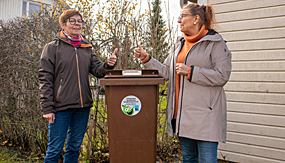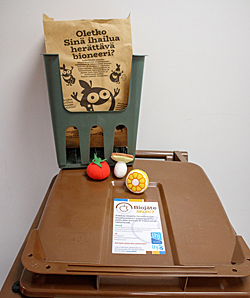
© Marianne Aro
A local waste management company in the Häme region started a campaign called Biokimppa to highlight the theme of their 25th anniversary: biowaste. The residents can, with their family or together with their neighbours, start using a new, ventilated BioSelect container that can be emptied only every four weeks, even in summer months.
“We want to encourage people to take up biowaste sorting by introducing alternatives to the familiar solutions,” says Environmental advisor Mirva Naatula from the waste management company of Loimi-Häme. The upcoming amendments in the Waste Act are a background factor. “We want to encourage people to start sorting biowaste well in advance, without having to force them.”
The Biokimppa service is available in 11 municipalities in the region with municipal biowaste collection. “Most interest towards the campaign was expressed in the larger towns in the area, like Forssa and Akaa.”
A paper bag ventilates the biowaste bin
The ventilated container features a false bottom, airing holes in the sides and plastic pads between the lid, improving the movement of air. “A biogrid is available in the bin, where a biowaste bag can be left out to dry and that accelerates the biowaste drying process,” Naatula mentions.
Starting biowaste sorting has been made easy. “We want to give the residents hands-on help and offer them a stack of paper bags that are needed to use the ventilated container, as well as a rack where the bags can be placed in the kitchen. A fibre package of some other type or even a sheet of newspaper can be used for this purpose.”
All the feedback received from users of the ventilated container has been positive. “When air flows in the container, the biowaste dries up and there are no odours,” Naatula points out. Even during the hot spells last summer, no-one reported smell nuisances, and there are less insects than before. “It is a good idea to keep the paper biowaste bag open in the kitchen to help the biowaste dry up, but then close it by rolling it tightly before putting it in the bin.”

BioSelect container © Marianne Aro
Containers are almost full when waste collectors come!
The BioSelect container has solved the issue that many households face: a biowaste container does not fill up in one or two weeks, which is the emptying schedule of standard-type biowaste containers according to the waste management regulations.
“Our waste collectors have a monitoring tool that they use to estimate the filling rate of biowaste containers in percentage points, and when emptied every week, the biowaste in single-family houses are often only 10–20 per cent full. But in four weeks they fill up easily,” Naatula says with content.
For her, the best feedback of the campaign has been that waste collectors have been emptying containers that are almost full. A ventilated container is more pleasant to work with for the waste collectors, too. “Even if the container is full, biowaste is drier in a ventilated container, so it is lighter to handle.”
Shared biowaste containers help make savings in waste payments

Biowaste is collected in a paper bag at home.© Marianne Aro
The campaign was targeted at single-family houses, but the BioSelect containers with longer emptying cycles are also a good alternative for small housing companies. The concept can be adapted according to the needs of the customers.
“The ventilated waste container is optimal for 1–4 households, but the largest Biokimppa solutions have up to 8–12 households. In these situations, we offer a standard biowaste container, because there is more biowaste collected in one or two weeks,” Natula mentions. There are good sides to neighbour cooperation. “This service with neighbours is a good idea, because it means that the expenses of biowaste collections will be shared.”
At present, many households have their own biowaste collection bins, but savings have been detected in these cases, too. Emptying a biowaste container only every four weeks makes it possible to extend the emptying cycles of mixed waste to up to eight weeks. “The waste management invoice can actually decrease with biowaste collection, if mixed waste has been collected every two weeks before this.”
The Biokimppa campaign has proved such a success that it will continue into 2021. “After that, the use of a ventilated biowaste container, alone or together with your neighbours, will continue as a standard service available at all times,” Naatula says.